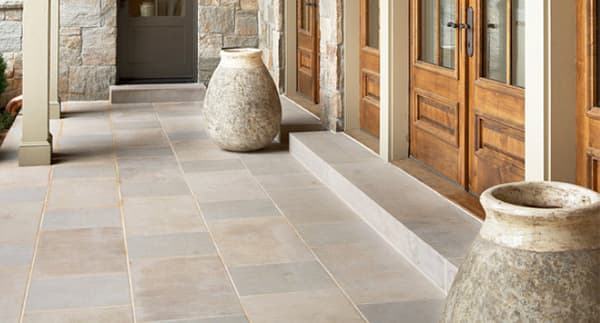A solid foundation is the key to any quality building project, and that’s definitely true when it comes to laying natural stone flooring. Whether you’re using tiles or slabs, it’s essential to prepare the surface properly before you start work.
Can I put stone tiles on a concrete floor?
Concrete or brick floors are a popular choice and are an ideal foundation for natural stone kitchen flooring as they’re even, solid and strong. Little preparation is required to put a stone floor on a concrete foundation, but a few basic precautions should be taken.
First, particularly if your property is older, it’s important to check that the surface is level. The fixing agent will even out minor irregularities, but larger issues can cause major damage. Tiles laid on an uneven surface are at a higher risk of cracking or breaking when furniture is placed on them. Second, a damp proof membrane should be laid before you start placing tiles. This prevents moisture creeping up into your home, and is a worthwhile investment.
Can I put stone tiles on beams and joists?
Few British houses are built of concrete – most are a mix of bricks and wood, with a beam and joist construction for the upper storeys. It’s entirely possible to lay natural stone floor tiles on beam and joist floors but it can be tricky, so this is a job best left to the professionals. The key factors to consider are: slab weight; support and level.
Stone kitchen tiles or slabs can be heavy, so it’s important to be sure that the materials you’re using won’t put too much pressure on the supporting beams and walls. As a general rule, it’s best to use thinner stone tiles for upper floors.
These in turn are relatively fragile – they’re still tougher than other flooring materials, like ceramic or wood, but not as tough as thicker slabs. As a result, it’s even more important that they’re properly supported and installed on a level surface. This typically means using boarding to create an even surface before the tiles are laid.
Can I put stone tiles on a wooden floor?
Laying natural stone tiles such as marble tiles or limestone tiles over an existing wooden floor is usually straight forward. As when laying stone tiles over beams and joists, it’s important to make sure the structure can support the additional weight. It’s also necessary to make sure the surface is flat.
Why do floors need to be so flat?
Natural stone flooring is incredibly tough, and will stand up to almost anything your family can throw at it. However, you can crack or break a stone tile if you place it on an uneven surface and put a heavy weight (like a person or furniture) on each side. It’s like breaking a piece of wood over your knee.
As a result, it’s critical that you ensure your surface is level before you lay ceramic or stone tiles – and the same rule applies outdoors as in, so if you’re laying paving for a patio, make sure you’re working on a flat surface.





